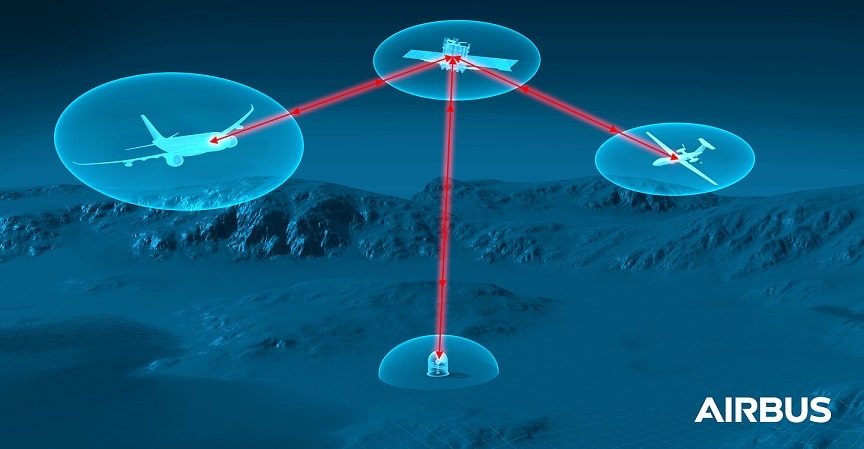Aerospace
Airbus and VDL Group join forces to produce an airborne laser communication terminal

A partnership agreement for the development and production of the UltraAir laser communication terminal for aircraft has been inked by Airbus and VDL Group. The Netherlands Organisation for Applied Scientific Research (TNO) and Airbus will lead the development, and the two organisations will now be ready for a prototype demonstration and first flying test in 2024.
UltraAir will enable the exchange of large amounts of data using laser beams in a network of ground stations and satellites in geostationary orbit at 36,000 km above the Earth. With unparalleled technology including a highly stable and precise optical mechatronic system, this laser terminal will pave the way for data transmission rates that could reach several gigabits-per-second while providing anti-jamming and low probability of interception.
UltraAir will allow military aircraft and UAVs (Unmanned Aerial Vehicles) to connect within a multi-domain combat cloud thanks to laser-based satellite constellations such as Airbus’ SpaceDataHighway. This is a key milestone in the roadmap of Airbus’ overall strategy to drive laser communications further, which will bring forward the benefits of this technology as a key differentiator for providing multi-domain combat collaboration for government and defence customers. In the longer term, UltraAir could also be implemented on commercial aircraft to allow airline passengers to establish high-speed data connections.
Regarded as the solution for data traffic in the quantum age, laser communication technologies are the next revolution in satellite communications (satcom). As satellite bandwidth demand is growing, the traditional satcom radio-frequency bands are experiencing bottlenecks. Laser communication brings 1,000 times more data, 10 times faster than the current network. Laser links also have the benefit of avoiding interference and detection, as compared to already-crowded radio frequencies they are extremely difficult to intercept due to a much narrower beam. Thus, laser terminals can be lighter, consume less power and offer even better security than radio.

Aerospace
Boeing Transfers Rocket Stage to NASA, Paving Way for Human Moon Mission

Boeing has achieved a significant milestone by providing NASA with the second core stage of the Space Launch System (SLS) rocket.
This crucial component, crafted at NASA’s Michoud Assembly Facility (MAF), is set to propel the Artemis II crew into lunar orbit, marking humanity’s return to deep space after a 50-year hiatus.
The monumental Boeing-built rocket stage, the largest element of the Artemis II mission, will embark on a journey aboard the Pegasus barge, traveling 900 miles to NASA’s Kennedy Space Center.
Comparison of two legendary aircraft B777x vs B747 aircraft:Click here
Upon arrival, it will be meticulously integrated with other essential Artemis II components, including the upper stage, solid rocket boosters, and NASA’s Orion spacecraft within the iconic Vehicle Assembly Building. This intricate integration process is a vital step toward the eagerly anticipated Artemis II launch, slated for 2025.
“Boeing-built products helped land humankind on the moon in 1969, and we’re proud to continue that legacy through the Artemis generation,” remarked Dave Dutcher, vice president and program manager for Boeing’s SLS program. “Together, with NASA and our industry partners and suppliers, we are building the world’s most capable rocket and paving the way to deep space through America’s rocket factory in New Orleans.”
NASA, Lockheed Martin Reveal X-59 Quiet Supersonic Aircraft:Click here
The delivery of Core Stage 2 marks a significant achievement in the evolution of the SLS rocket. Towering over 200 feet and powered by four RS-25 engines, this core stage, coupled with two solid-fueled booster rockets, will generate a staggering 8.8 million pounds of thrust. This immense power is crucial to launching Artemis II and future missions into the vast expanse of space.
The SLS rocket stands unparalleled in its capability to transport both crew and substantial cargo to the moon and beyond in a single launch. Its extraordinary capacity will facilitate the delivery of human-rated spacecraft, habitats, and scientific missions to destinations including the moon and Mars, ushering in a new era of space exploration.
-

 Travel1 week ago
Travel1 week agoAir India to Expand US Operations with Three New Routes After a Decade
-

 Travel2 weeks ago
Travel2 weeks agoWhy We Should Avoid These Stamps in a Passport
-

 Airlines1 month ago
Airlines1 month agoInvestigations Reveal Fake Chinese Titanium in Boeing and Airbus Jets
-

 Tech4 weeks ago
Tech4 weeks agoChina’s CATL Plans 1,800-Mile Electric Plane Launch by 2027
-

 Airport3 days ago
Airport3 days agoTop 10 Largest Airports in the World by Size
-

 Aerospace4 weeks ago
Aerospace4 weeks agoChina’s Fighter Jets Turn Wings into Autonomous Drones
-

 Airlines4 days ago
Airlines4 days agoAir India Rolls Out A350s for Delhi-New York JFK and Newark Routes
-

 Defence3 weeks ago
Defence3 weeks agoBoeing Enhances Chinook with New Engines and Block II Upgrades at $96 Million







